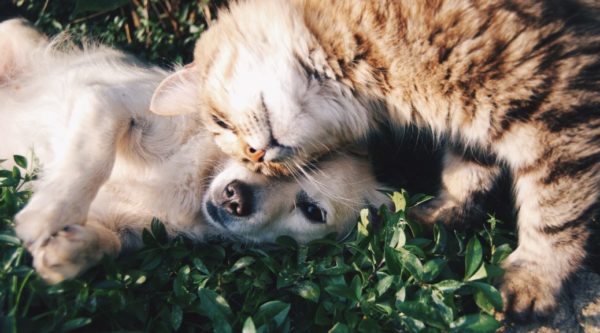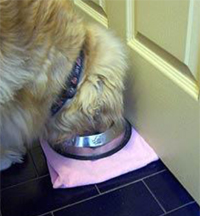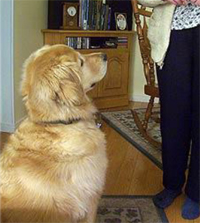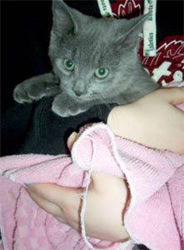Helping your Adopted Cat – and Existing Pets – to Accept Each Other
by Ontario SPCA and Humane Society | Cat Care Pet Planning | November 9, 2018
 Adjusting to a new home can be a frightening and anxious experience for a cat who may have been bounced from one or more homes, to a shelter, and then to you. Do not be discouraged if your new and resident pets do not become immediate friends. It can take many cats 8 to 12 months to develop a friendship. Others may never become friends and simply learn to live together by mutual avoidance. Occasionally, one cat must be re-homed because the animals will not stop fighting.
Adjusting to a new home can be a frightening and anxious experience for a cat who may have been bounced from one or more homes, to a shelter, and then to you. Do not be discouraged if your new and resident pets do not become immediate friends. It can take many cats 8 to 12 months to develop a friendship. Others may never become friends and simply learn to live together by mutual avoidance. Occasionally, one cat must be re-homed because the animals will not stop fighting.
While there is no definitive way to determine whether your cat will get along with a particular animal, often the cats that adjust easiest are those who’ve lived previously with other animals, or are still kittens. Older cats that have never been around other animals may have the most difficult time adapting.
Regardless of the age or background of the cat you’ve adopted, it’s important to remember that cats are territorial and must be introduced to other animals gradually to help prevent fearful or aggressive responses. Below are some tips and tricks to help increase the chance your adopted cat will accept – and be accepted by – the rest of your furry family. Prior to bringing a new pet home check with your veterinarian to ensure all your resident pets are healthy (as well as your new addition).
Note: Keep in mind that while some cats will be able to breeze through each step after only a couple of days, other cats will require weeks at each step before they are able to take the introductions further. Be patient and allow your cat the freedom to move through each step at his or her own comfort level.
Step one: Creating a good first impression

During the early stages of the introduction period it’s important that your new and resident pets can smell and hear one another but not touch. To prevent accidental face-to-face confrontations confine your cat to a medium- sized room with her food, water, litter box and a bed. Plan ahead for your pet’s arrival by ensuring your resident pets are temporarily confined until your new cat is in her room.
To help your pets associate positive experiences with one another start feeding their meals on either side of the door to this room so they are in close proximity. At first their dishes should be placed at least a few feet apart on each side. If they remain calm, gradually move the dishes closer until they can eat comfortably standing directly on either side of the door. If either animal has a negative reaction, move the dishes further apart and repeat the process at a slower pace.
Step two: Building familiarity
 Allowing your pets to gradually become accustomed to each other’s scents is an important part of the introduction process. Two excellent ways to exchange scents include rubbing a towel on your new addition and putting it under the food dishes of the resident pets (and vice versa), and switching beds or sleeping blankets between your resident pets and your new cat.
Allowing your pets to gradually become accustomed to each other’s scents is an important part of the introduction process. Two excellent ways to exchange scents include rubbing a towel on your new addition and putting it under the food dishes of the resident pets (and vice versa), and switching beds or sleeping blankets between your resident pets and your new cat.
Once your new and resident pets have a chance to become familiar with each other’s scents using these methods, and your new cat is eating regularly and using his litter box in the room he’s been confined, switch it so that your resident pets are confined to the new cat’s room and your new cat is free to roam the house. This allows your pets to have yet another chance to adjust to each other’s scents, and gives the new cat freedom to calmly explore his new home.
Step three: Allowing for peek-a-boos
Once you’ve returned your pets to their original designated parts of the house you can start the peek-a-boo process. Use two doorstops to prop open the dividing door enough to allow your new and resident pets to see each other while eating. Over a period of days (or longer if necessary) try feeding your pets at a distance from the door gradually bringing the dishes closer together if all pets display calm behaviours. Close the door when you are not there to supervise.
Step four: Making the introductions (cat-to-cat)
When you first allow your cats to meet each other face-to-face be prepared for a slight protest from either cat on occasion. Do not allow these behaviours to develop further. If either animal becomes fearful or aggressive, separate them, and start back at step one taking small, gradual steps forward again. When minor spats occur between your cats – such as posturing, hissing or growling – you can safely separate your pets by making a loud noise, using a squirt bottle with water or throwing a pillow.
It’s important to note that sometimes when pets are introduced a pet makes play signals that are interpreted by the other pet as aggression. If this occurs, separate your pets and contact your veterinarian or an animal behaviourist immediately for assistance.
To help ease the adjustment period for your cats ensure that you have one extra litter box than there are cats (e.g. two cats, three litter boxes), watch to ensure that the cats don’t “ambush” each other when trying to use the litter box, and keep the resident pets’ schedules close to what they were before the newcomer’s arrival.
Introducing your cat to your dog
Because dogs have strong jaws, are typically much larger than cats, and have a natural tendency to want to chase and play with cats (who typically become fearful and defensive) – caution is needed when making introductions. Be particularly careful of dogs with high prey drives. Some dogs should never be left alone with cats without supervision. To safely introduce a cat and dog to each other take the steps referred to above in addition to the following precautions.
Ramping up training

Training is invaluable to help teach your dog to behave appropriately around cats. Work on improving your dog’s response to sit, down, stay, come and attention commands so she can respond reliably with distractions. If you need help, join a positive reinforcement training class. Modern trainers use humane and fun techniques such as “lure- rewarding” (using treats to lure dogs into position), and “clicker training” (marking the exact moment the dog is doing the desired behaviour using a small device that makes a “click” – followed by feeding a treat).
Controlling introductions
 When your cat and resident dog are comfortable eating on opposite sides of the door (as described in steps one to three) you can start the gradual process of introducing your pets to one another. Use two people in this exercise to help ensure the introductions are safe and positive. One person should take the dog on leash to a corner of the room and have him lie down and stay for treats. Have a second person offer your cat tasty pieces of food at the opposite end of the room. Repeat this exercise many times (keep the sessions short and successful rather than long and stressful for the animals) gradually bringing your pets closer together as long as they continue to show calm behaviour.
When your cat and resident dog are comfortable eating on opposite sides of the door (as described in steps one to three) you can start the gradual process of introducing your pets to one another. Use two people in this exercise to help ensure the introductions are safe and positive. One person should take the dog on leash to a corner of the room and have him lie down and stay for treats. Have a second person offer your cat tasty pieces of food at the opposite end of the room. Repeat this exercise many times (keep the sessions short and successful rather than long and stressful for the animals) gradually bringing your pets closer together as long as they continue to show calm behaviour.
If the controlled introductions are going smoothly when your dog and cat are close together, keep your dog on leash in a down-stay position but allow your cat some freedom to explore your dog at his own pace. Praise and give treats for calm behaviour. If your dog pops out of position quickly reposition your dog in a down posture using a tasty treat as a lure.
Note: If your cat shows fearful behaviour and runs away, or becomes aggressive, go back to the previous introduction steps at a slower pace. Also, if you are concerned your dog may jump up during introductions and startle your cat, you can “ground” the leash. To do so, step on the leash at the point where it touches the ground if your dog is standing. If he attempts to jump to say hello, the leash will momentarily tighten, and he will correct himself. Give him lots of rewards for calm behaviour. Ensure your dog is wearing a flat collar – not a choke chain or prong collar – which can cause him to associate pain and/or discomfort with the presence of the cat.
Teaching dogs math: cats = good things happen
If you are constantly stressed or punishing your dog when your cat is nearby, such as keeping the leash taunt, popping the leash or yelling at your dog – and “good things” never happen to your dog in the cat’s presence – your dog may come to associate these negative experiences with your cat and redirect aggression towards her. Consequently, it is important that you give your dog treats and praise whenever she is calm around your cat, and whenever she responds to your requests to sit, come or lie down. Help her be successful with treats! In the early stages of introduction you can give lots of treats, however, as your dog adjusts to the cat and noticeably becomes more relaxed in her presence you can give treats randomly and with decreasing frequency.
Protecting unsupervised cats, kittens and puppies
 Throughout the introduction process ensure your dog is on leash, supervised, and well treated for good behaviour and good responses to requests. If you are not home keep pets in separate areas of the house or set up barriers, such as baby gates, to limit your dog’s freedom and give your cat “dog-free” zones he can retreat to for safety if needed.
Throughout the introduction process ensure your dog is on leash, supervised, and well treated for good behaviour and good responses to requests. If you are not home keep pets in separate areas of the house or set up barriers, such as baby gates, to limit your dog’s freedom and give your cat “dog-free” zones he can retreat to for safety if needed.
Kittens, because of their small size, should not be left unsupervised around dogs. Cats are generally safe around puppies, as a well socialized cat can put a puppy in its place; however, shyer cats may not be so bold and need to be separated until the puppy is older and learns self- control.
Protecting small animals
If you own small pets that are the natural prey of cats – such as rodents, birds and fish – ensure they are protected from possible harassment from the new cat. Never leave your pets together unsupervised until you are sure they can peacefully coexist. Often the best and safest solution is to keep your small animals in a separate area of the house. Small pets can be stressed simply by the presence of your cat.
Calling for extra help
If introductions go poorly, early intervention and advice from a professional is recommended to increase the likelihood the conflict can be resolved and to reduce the risk of injury from a pet fight. Recommended professionals include animal behaviourists, veterinarians, or dog trainers if a dog is involved. Do not attempt to punish any of your pets as this can easily make the situation worse and make the pets more aggressive or fearful. Fortunately, with professional guidance most pets can learn to live together peaceably.
Categories
Testimonial
For every animal you save
For every animal you save, every animal who feels loved in their last moments, and for everything else you do; thank you and God Bless.
